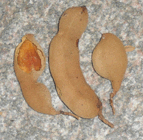The Versatile Tamarind: A Culinary Gem
Tamarind, with its unique sweet and sour flavor, is a staple ingredient in households across India, the Middle East, and Southeast Asia. This exotic fruit, known for its brown, tart yet sweet-flavored pulp, is not only delicious but also offers numerous health benefits. From curries to chutneys, tamarind adds a distinctive tangy taste to a wide variety of dishes.
Selection and Storage
When selecting tamarind, opt for fresh unbroken pods if available. If purchasing processed tamarind products, choose a reputable brand to ensure quality. Store tamarind pods or pulp in the refrigerator to maintain freshness for several months.
Culinary Uses
There are endless culinary possibilities when it comes to tamarind. In Indian households, tamarind pods are opened to extract fresh pulp for cooking. The pulp can also be soaked in warm water to create a sauce that can be used in curries, soups, marinades, and confectionaries. Tamarind juice, mixed with ingredients like dates, sugar, and spices, makes a refreshing drink enjoyed worldwide.
Serving Tips:
- Use tamarind in curries, rasam, chutneys, and lentil dishes.
- Add tamarind pulp to hot and sour soups or marinades for a tangy kick.
- Blend tamarind juice with dates, sugar, and spices for a flavorful drink.
- Employ tamarind pulp as a solidifying agent in confectionaries.
Safety Profile
Tamarind is generally safe for consumption and has no reported cases of allergies or toxicity. It can be used in cooking by pregnant and nursing mothers without any known risks.
FAQs
Q: Can tamarind be used in desserts?
A: Yes, tamarind can be used in desserts to add a unique sweet and sour flavor profile. It pairs well with ingredients like sugar, honey, and spices.
Q: What are the health benefits of tamarind?
A: Tamarind is rich in vitamins, minerals, and antioxidants. It may aid digestion, promote heart health, and help regulate blood sugar levels.
Conclusion
In conclusion, tamarind is not just a flavorful ingredient, but also a versatile culinary gem with a range of health benefits. Whether used in traditional Indian dishes or creative fusion recipes, tamarind adds a delightful tanginess that enhances the overall flavor profile of a dish. So, next time you’re in the kitchen, consider incorporating tamarind for a burst of exotic flavor.
